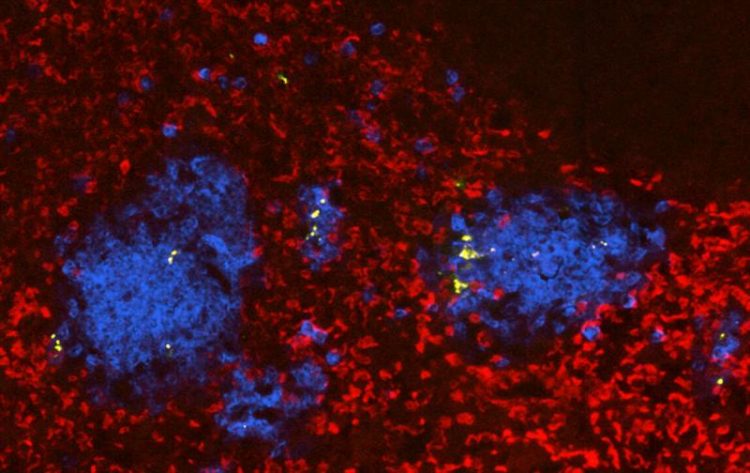Protein Sharpens Salmonella Needle for Attack

Section of a Salmonella (yellow) infected spleen (red: red blood cells; blue: neutrophils). (Fig.: University of Basel, Biozentrum)
A team of scientists at the Biozentrum of the University of Basel demonstrate in their current publication in Cell Reports that a much investigated protein, which plays a role in Salmonella metabolism, is required to activate these needles and makes the replication and spread of Salmonella throughout the whole body possible.
The summer months are the prime time for Salmonella infections. Such an infection is caused by the ingestion of contaminated food, for instance ice cream or raw eggs, and can cause severe diarrhea. Salmonella can even cause life-threatening illnesses such as typhoid fever.
For several years, Prof. Dirk Bumann, from the Biozentrum of the University of Basel, has been studying the infection mechanisms of Salmonella. Together with his team, he has discovered that the bacterial protein EIIAGlc is not only responsible for the uptake of nutrients, which was previously known, but also plays a central role in Salmonella colonizing the host organism.
New function discovered for well known protein
Salmonella possesses a sophisticated injection apparatus, the type III secretion system. With this molecular syringe, it injects toxins directly into the host cells. These toxins manipulate host cell processes to create optimal growth conditions for the bacteria in hiding. Unforeseen, Bumann and his team uncovered an important teammate in the infection process, the protein EIIAGlc. The protein was already known for its many functions in bacterial metabolism, such as in the uptake of sugars molecules.
The researchers’ attention was attracted by the fact that when EIIAGlc is defective Salmonella completely loses its capacity for intracellular replication and to spread throughout the organism. Further investigations finally brought the scientists from Basel onto the right track. The protein EIIAGlc docks onto the injection apparatus in the bacterium, stabilizes it and finally activates the release of the toxins. “We can clearly demonstrate that the activation of the secretion system is the main function of the protein EIIAGlc, while the many other described metabolic functions play a minor role in the occurrence of illness”, says Bumann bringing his findings to the point.
Target molecule for antibiotic treatment
It is estimated that each year about 16 million people worldwide contract a life-threatening Salmonella infection that affects the whole organism. The spread of the bacteria in the host is highly dependent on the functional capacity of the injection system. “In EIIAGlc, we have found a new potential therapeutic target”, says Bumann. By inhibiting the protein, one could strategically put the infection apparatus out of action. As this injection needle is primarily found in pathogens, infections could be
Original source
Alain Mazé, Timo Glatter, Dirk Bumann
The central metabolism regulator EIIAGlc switches Salmonella from growth arrest to acute virulence through activation of virulence factor secretion
Cell Reports, published online 15 May 2014
Further information
Prof. Dr. Dirk Bumann, University of Basel, Biozentrum, phone: +41 61 267 23 82, email: dirk.bumann@unibas.ch
Media Contact
More Information:
http://www.unibas.chAll latest news from the category: Life Sciences and Chemistry
Articles and reports from the Life Sciences and chemistry area deal with applied and basic research into modern biology, chemistry and human medicine.
Valuable information can be found on a range of life sciences fields including bacteriology, biochemistry, bionics, bioinformatics, biophysics, biotechnology, genetics, geobotany, human biology, marine biology, microbiology, molecular biology, cellular biology, zoology, bioinorganic chemistry, microchemistry and environmental chemistry.
Newest articles

High-energy-density aqueous battery based on halogen multi-electron transfer
Traditional non-aqueous lithium-ion batteries have a high energy density, but their safety is compromised due to the flammable organic electrolytes they utilize. Aqueous batteries use water as the solvent for…

First-ever combined heart pump and pig kidney transplant
…gives new hope to patient with terminal illness. Surgeons at NYU Langone Health performed the first-ever combined mechanical heart pump and gene-edited pig kidney transplant surgery in a 54-year-old woman…

Biophysics: Testing how well biomarkers work
LMU researchers have developed a method to determine how reliably target proteins can be labeled using super-resolution fluorescence microscopy. Modern microscopy techniques make it possible to examine the inner workings…





















